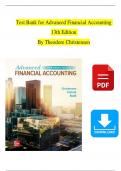Exam (elaborations)
TEST BANK For Advanced Financial Accounting 13th Edition By Theodore Christensen Chapter 1 - 20 |Complete Newest Version
TEST BANK For Advanced Financial Accounting 13th Edition By Theodore Christensen Chapter 1 - 20 |Complete Newest Version TEST BANK For Advanced Financial Accounting 13th Edition By Theodore Christensen Chapter 1 - 20 |Complete Newest Version TEST BANK For Advanced Financial Accounting 13th ...
[Show more]




